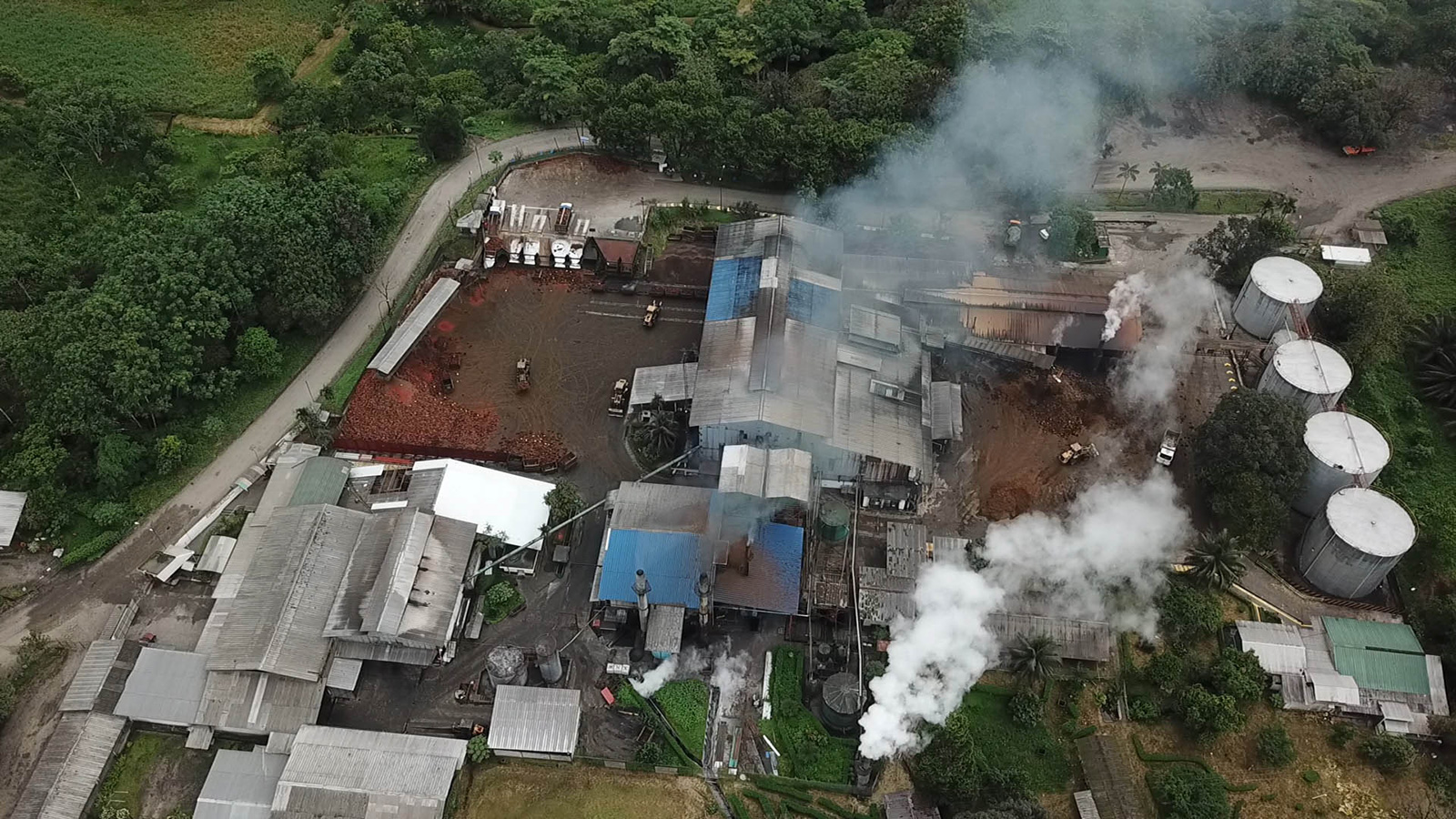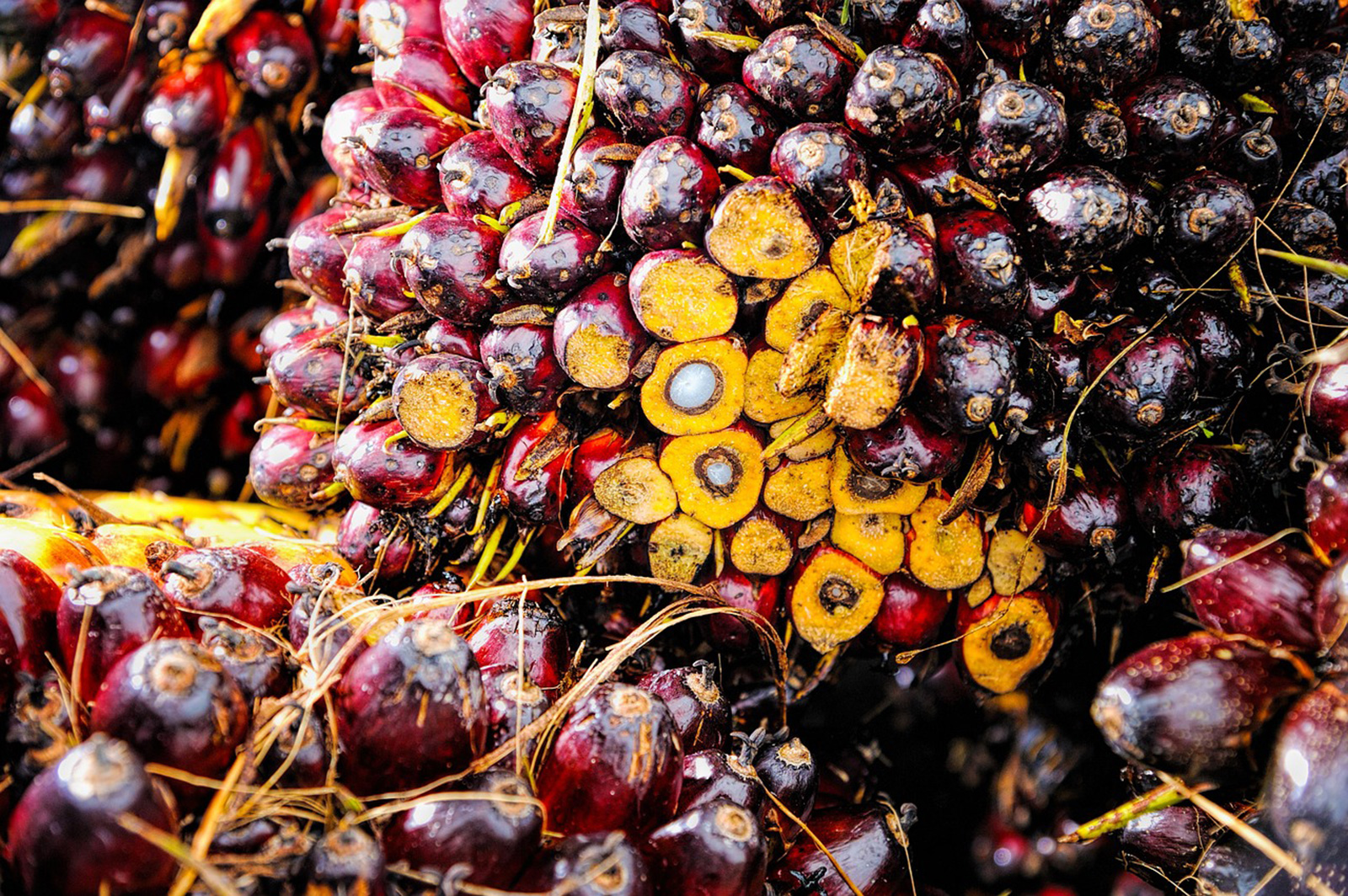
There are palm oil trees as far as the eye can see, like so many dominoes lined up ready to fall where once a wild, swirling old-growth forest stood. Countless open-backed trucks, piled high with palm fruit, trundle along the dirt road ferrying this fat-rich edible to the eagerly awaiting world. The clusters of bright red fruit, clinging together like a giant bunch of grapes, contain not only a much-coveted oil, but the very constituents of this nutrient-poor Amazonian soil. Ton after ton of precious biological building blocks exit this tropical ecosystem to then be integrated into processed foods sold primarily in countries in Europe and North America where, after passing through arteries and intestines, they will come to rest in a steaming heap of human feces.
What is driving such a wholescale transfer of material from one place to another? And what are the consequences of this elaborate scheme to us humans?

Palm oil processing plant in the Ecuadorian Amazon
The Goldilocks Oil
Palm oil has been used in West African cooking for millennia. It first hit the international circuit when British sailors recognized its convenience on long sailing trips in 1917 and is now grown all over the tropics, including the Amazon. The ascent of palm oil in recent years is partly due to its Goldilocks nature: it’s neither too solid nor too liquid at room temperature, making it versatile for the food industry. Further, the African palm tree actually yields two products in one: a more liquid oil from the fruit pulp and a more solid oil from the fruit pit. As part of a traditional, balanced diet in Africa, palm oil contributed positively to nutrition; however, some of the beneficial qualities are lost in the refining process (Mancini et al., 2015) and overconsumption is becoming a global health problem. More on Goldilocks later.

African Oil Palm Elaeis guineensis fruit
Health Pitfall #1: Looting the Amazonian Ecosystem
Local indigenous people depend on intact ecosystems for many aspects of their health. Studies are beginning to document the ways in which palm oil plantations contribute to deforestation and damage ecosystem integrity. An examination of Peru’s company-community model for palm oil development, in which communities partner with larger companies, discovered that these partnerships led to greater deforestation spillage into surrounding forests, social unrest and environmental damage (Bennett et al., 2018). In that palm oil plantations often lead to deforestation of old-growth forest, their apparition contributes to climate change and associated health risks. For example, a study in Brazil determined that palm oil would contribute to the water deficit of the Maranhão region because from July through December the rainfall would be insufficient to replace evapotranspiration and thus the plantations would require irrigation (Martorano et al., 2017).

Palm oil plantations are now a major driver of deforestation in the Ecuadorian Amazon
Health Pitfall #2: Threatening Indigenous Food Sovereignty
As forests fall to make room for row after row of palm trees, local people’s food sovereignty, their capacity to exercise control over their own food, is threatened along with their health (Weiler et al. 2015). Palm oil eats away at indigenous people’s food sovereignty through two interrelated economic process. Every hectare of palm is a hectare in which Amazonian indigenous people cannot hunt and gather their traditional foods. When indigenous people no longer have access to traditional diets they turn to western diets rich in palm oil with consequences (linked to Health Pitfall #4). Further, the international demand for palm oil drives up prices and makes its production more profitable than the production of more nutritious foods or the protection of the rainforest.

Secoya shaman in what was once ancestral hunting grounds, Ecuadorian Amazon
Seen from this perspective, those in the developed nations who consume the lion’s share of palm oil are often unknowingly looting the Amazonian ecosystem by denuding the soils, parsing down biodiversity, impeding food sovereignty and stripping away its moisture.
Health Pitfall #3: Poisoning the people
“It’s a bit of a mystery as to which pesticides they are using– after some research we were not able to get a list of all of them,” lamented Sandra Damiani, a researcher at the University of Brasília who studies the negative socio-environmental impacts of palm oil plantations on the Tembé people living in the Brazilian Amazon. “Unfortunately, this information is not readily available. In order to control use, you have to have access to information on what is being used.” What she did learn is that – world-wide – a total of 23 herbicides and insecticides are used in palm oil production. A recent article found that Ecuadorian farmers growing palm oil in the Amazon use copious amounts of pesticides and that these chemicals have been polluting the Shushufindi River for over 30 yrs.

Secoya family fishing on the Shushufindi River, Ecuadorian Amazon
According to Damiani, there is also a lack of data on how these pesticides affect people living near plantations. What we know about the effects of these chemicals comes from laboratory or occupational studies, in which exposure routes and doses are different. Damiani’s study documented residues of pesticides, among them Glyphosate and Endosulfan, in streams, sediments and wells (Damiani, 2017). From this, and based on indigenous people’s perceptions of the environmental risks of palm oil crops, her team believes that the aquatic biota, including fish, and the communities that rely on this water could indeed be exposed to these harmful substances.
In fact, people participating in the study reported headaches, itching, diarrhea, vomiting, and skin irritations, especially around the time of the implementation of the plantation, when pesticide use was at its peak. Many of these pesticides are hormone disruptors, explained Damiani. Hormone disruptors act on the body’s complex and nuanced hormone system, which regulates many aspects of health. Women are particularly vulnerable to the damage that hormone disruptors cause, including, early puberty, infertility, polycystic ovarian syndrome, uterine fibroids, miscarriage, and breast cancer.
In addition to the physical effects perceived by indigenous people, they also self-report psychological impacts, such as fear, which they attribute to the surrounding palm oil crops. “According to their narratives, because of the palm plantations, they were not able to use the natural resources they have freely and without fear. This created a lot of tension.” If people cannot depend on their natural resources, their food sovereignty is compromised.
Health Pitfall #4: Thwarting trends toward low-saturated fat diets
Remember Goldilocks? Palm oil’s Goldilocks’ nature also means that it is neither too saturated nor too unsaturated. It is composed of about 50% saturated fat (45% for the “fruit” and 82% for the kernel) (Misra et al. 2010), placing it about half-way between other vegetable oils and lard on a fat spectrum. Because of its fairly solid-at-room-temperature quality it has largely replaced hydrogenated oils since many countries began to ban trans-fats.
However, its climb to the number one spot of oils in the food industry has essentially counterbalanced a trend toward less saturated fats in the diets of the industrialized world as animal fats have fallen out of favor (Chen et al. 2011). People do not recognize that palm oil – often listed on packaging as simply ‘vegetable oil’ – has a higher percentage of saturated fats than most vegetable oils.
A multi-country study found that mortality from ischemic heart disease (IHD) increased significantly with increasing palm oil consumption and especially so in developing countries, where healthy traditional diets are being replaced by high-fat diets, including in Ecuador (Chen et al. 2011).
It is difficult to get a clear sense of the true impacts of palm oil on human health because the palm industry, like the tobacco industry, invests heavily in health research. Of 51 studies in a systematic review, 31 had private sector support: 19 of these were backed by the Malaysian Palm Oil Board. Indeed, this same review found that changes in cardiac health indicators resulting from a change in diet away from palm oil “were less evident in studies funded by the Malaysian Palm Oil Board than in those funded by other private or public institutions” (Fattore et al. 2014; p. 1347). As palm oil replaces trans-fats in processed foods, usurping other vegetable oils, consumers are duped into believing that they are making healthy choices. Goldilocks has lulled us all into a deep slumber on that not too hard, not too soft bed of hers.
Domino effect
Which of these dominos will be the first to fall? Waking the food industry and consumers out of their reverie? Because tropical ecosystems cannot sustain our voracious appetite for oil in processed food much longer. Palm oil is increasingly recognized as harming health through 1) ecosystem degradation, 2) threatening food sovereignty, 3) pesticide exposure and 4) saturated fats. There is a growing movement of people concerned by the impacts of palm oil on health and tropical ecosystems and a growing number of tools aide consumers in knowing if their products contain palm oil and, importantly, if it is sustainably sourced (e.g.: https://orangutan.org/app/). However, studies have shown that replacing palm oil with other vegetable oils will actually increase the amount of land dedicated to oil production, because palm oil yields more oil per hectare than alternatives. So just switching oils is not the solution. Reducing global consumption of processed foods containing oils is the solution. Share what you know and believe. You can be the instigator that sets the dominos in motion.
References
- I would like to thank Ben Brisbois for his help with the literature review.
- Bennett, A., A. Ravikumar and H. Paltán (2018). “The Political Ecology of Oil Palm Company-Community partnerships in the Peruvian Amazon: Deforestation consequences of the privatization of rural development.” World Development 109: 29-41. https://www.sciencedirect.com/science/article/pii/S0305750X18301207
- Chen, B. K., B. Seligman, J. W. Farquhar and J. D. Goldhaber-Fiebert (2011). “Multi-Country analysis of palm oil consumption and cardiovascular disease mortality for countries at different stages of economic development: 1980-1997.” Globalization and health 7: 45-45. https://globalizationandhealth.biomedcentral.com/articles/10.1186/1744-8603-7-45
- Damiani, S. (2017). Impactos socioambientais do cultivo de dendê na terra indígena turé-mariquita no nordeste do pará. Master in Sustainable Development, Universidade de Brasília. http://repositorio.unb.br/handle/10482/31503
- Fattore, E., C. Bosetti, F. Brighenti, C. Agostoni and G. Fattore (2014). “Palm oil and blood lipid–related markers of cardiovascular disease: a systematic review and meta-analysis of dietary intervention trials.” The American Journal of Clinical Nutrition 99(6): 1331-1350. https://academic.oup.com/ajcn/article/99/6/1331/4577394
- Mancini, A., E. Imperlini, E. Nigro, C. Montagnese, A. Daniele, S. Orrù and P. Buono (2015). “Biological and Nutritional Properties of Palm Oil and Palmitic Acid: Effects on Health.” Molecules (Basel, Switzerland) 20(9): 17339-17361. https://www.mdpi.com/1420-3049/20/9/17339
- Misra, A., N. Singhal and L. Khurana (2010). “Obesity, the Metabolic Syndrome, and Type 2 Diabetes in Developing Countries: Role of Dietary Fats and Oils.” Journal of the American College of Nutrition 29(sup3): 289S-301S. https://tandfonline.com/doi/full/10.1080/07315724.2010.10719844
- Martorano, L. G., J. R. S. C. de Moraes, L. S. S. Lisboa, R. A. G. Junior, V. P. do Amaral and L. E. O. Aparecido (2017). “Expansion of palm oil (Elaeis guineensis Jacq.) in the state of Maranhão and soil water deficit limitations in the Brazilian Amazon.” Australian Journal of Crop Science 11(11): 1386-1391. https://www.frontiersin.org/articles/10.3389/fpls.2015.00190/full
- Weiler, A., C. Hergesheimer, B. Brisbois, H. Wittman, A. Yassi and J. Spiegel (2015). “Food sovereignty, food security and health equity: a meta-narrative mapping exercise.” Health Policy and Planning 30: 1078–1092. https://academic.oup.com/heapol/article/30/8/1078/555203




